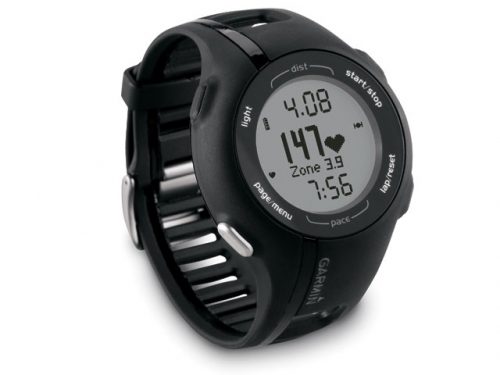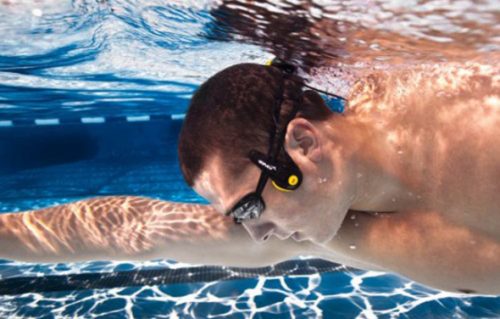For most casual to intermediate level runners, the Garmin Forerunner 210 is the right watch.
(Last Updated July 11, 2012: The folks at Magellan have released their first two fitness watches, the Magellan Switch and Switch Up. These new contenders are aimed more at triathletes than runners, and both are a bit rough around the edges in some significant ways, so our pick remains the simple, solid Garmin Forerunner 210. Still, I’ve added a bit about Magellan’s offerings below.)
It’s hard to be honest with ourselves about exercise. We tell ourselves this will be year we get in shape–Walking! Jogging! Running! Maybe even swimming, which we hear is like, the best workout ever–and for a week, or maybe a month, or maybe a few months, we do. But then we don’t. Because exercising is hard work. And a watch ain’t gonna make it any easier.
You’re still the one responsible for getting your lacing up your shoes and getting your lazy butt out the door. So we suggest setting some sort of goal, maybe a solid month of exercise, and then rewarding yourself with one of these devices once you’re convinced you’re in it for the long haul. All that being said, there are a host of watches that can provide incredible feedback on your exercise and keep track of what you’re doing as you get into the best shape of your life. All that data might even boost your commitment levels. A bit.
Of the several dozen fitness watches on the market, you’ll find ones that cater to every sort of fitness type, from reformed couch potatoes to Triathaloners who run, bike, and swim with equal zeal. But the basic purpose is the same: strapping one of these GPS-equipped watches on your arm lets you to check data like time, distance, and pace at a glance as you’re running, as well as allowing you to go back and review that same data, along with maps of your routes and more detailed workout information when you’re back at your computer. If you pair your watch wirelessly with a heart rate monitor–typically an armband you can buy as a separate accessory–you can get data on your heart rate as you workout, too. But these are just the basics. The more advanced watches have features which let you program complex interval workouts, race against your best times on certain runs, and even remind you to hydrate periodically during longer workouts. Thanks, watch.
Our recommendation, the $200 Forerunner 210, is far from the most advanced of the lot, but its ease of use and broad feature set for a watch of its price make it a standout pick. Ray Maker, the running gear guru behind DCRainmaker.com, home to what are likely the web’s most exhaustive fitness watch reviews, lists it as one of his two top recommendations for the general runner category. In his review of the watch, he explained, “I find that for 95% of runners, the FR210 is the perfect running watch. It offers a completely streamlined look and an easy to use interface. It’s also the best overall introduction into GPS enabled fitness devices, without the complexity of some of the other units out there.” Sean Downey, the running watch guy over at Runner’s World, also recommended the Forerunner 210 as the best overall entry-level choice: “It offers a little more bang for the buck than the Timex Run Trainer and the Nike SportWatch and it’s easier to use. The 210 just has a terrific balance of features and price.”
One of the most important characteristics of a good running watch is ease of use, and here the FR210 excels. As the Rainmaker summarizes, with this model Garmin set out to “design a watch that’s both easy to use and hard to get confused by.” Turn it on, answer a few questions about your preferred measurements, as well as your weight and age, and you’re ready to run. The 210 lets you view the basic data points on-arm during your run–pace, either at a given moment or as an overall average; distance, time, and heart rate (with purchase of the additional heart rate monitor)–but records a wealth of other data for scrutiny back on your computer. The watch handles interval training, too, allowing you to specify the length of intervals, warm-up periods, rests, and cool downs after your workout, all of which can be set up on the watch itself or in Garmin’s software. It’s got a backlight for nighttime runs, an 8-hour active battery life, and an uncommonly slim design–you’ll feel like you’re actually wearing a watch, rather than some space-age timepiece that takes up half your forearm.
Garmin’s more expensive watches, like the $350 Forerunner 610, offer niceties like wireless data uploading and touchscreen navigation, as well as features like auto pause (when you’re stopped at a crosswalk, say), pace alerts, and a virtual race feature which you can use to compete against your best times on certain routes. But $350 is a lot for a new runner to spend on a fitness watch, and in terms of core functionality, the 210 gets the job done and then some. The Forerunner 410 is a more modest step up at $250, but its finicky touch-sensitive bezel can end up being more of a pain to use than the 210’s hardware buttons. The Forerunner 110 is the slightly older, entry-level GPS sibling of the 210, and though it’s $20 cheaper, it’s missing key features like instant pace and foot pod support for treadmill use. And those are two you’ll actually want at some point.
Along with a Garmin watch comes access to Garmin Connect, a powerful web-based portal that gives you an overview of each run (maps, summaries of time, distance, elevation, heart rate [if applicable], and charts out the wazoo). You can replay your runs and watch the data pile up in real time, or you can jump back for a calendar view of all your workouts. Garmin Connect is intuitive enough for beginners and should be powerful enough for most users, though the 210 plays nice with more advanced third party software like Training Peaks and other popular applications like RunKeeper.
Though the 210 isn’t designed explicitly for cycling, it does let you switch the unit for “Pace” from minutes per mile to the more useful miles per hour. It is not, however, designed for use in the pool, though it’s designed to withstand rain and the occasional trip into the shower.
If cycling and swimming are going to be part of your routine, the Garmin Forerunner 910XT is your best bet. Mat Honan gave it the Bestmodo distinction in Gizmodo’s recent fitness watch roundup: “It is, quite simply, the total package. This is the fitness device I’ve wanted for years. It it the culmination of so many things Garmin has done well over the years fully realized.” But it’s also $400 and overkill if you’re not going to be doing serious training on your bike or in the lap lanes.
There are other compelling entry-level watches, though, that stack up decently against the Forerunner 210. The Rainmaker likes the Timex Run Trainer, which offers more customization than the 210 in terms of how you view your data, though other reviewers find the watch itself overly bulky and its software difficult to navigate. The Nike+ Sportswatch GPS, at $170, is undeniably sleek–Sean Downey of Runner’s World says its web-based tracking software is “much more intuitive than anything else out there”–and it comes bundled with Nike’s foot pod for tracking treadmill use and running cadence, something you’ll have to pay an additional $50 or so for with the Garmin models. But Nike’s watch is unapologetic about being built for beginners. There’s a dearth of advanced features, like heart rate zones; there’s no way to switch to a miles per hour mode for cycling; and Nike’s site only gives you a general, mile by mile view of your data–there’s no way to dive in and check out how your pace, say, or heart rate changed minute by minute. Even more damming: Nike doesn’t let you export your data out from its website. No good.
The Magellan Switch, at $230, is water resistant to 50 meters and offers a variety of cycling modes (as opposed to the FR210’s simple unit-switching), but Ray Maker found that the watch suffered from wild fluctuations when reporting instant pace, essentially rendering that fairly essential metric useless. It also uses open source maps instead of the familiar ones from Google or Bing, and, Maker notes, they’re pretty rudimentary by comparison. These are the types of issues that could be addressed with future firmware updates, but for now they represent significant drawbacks.
One thing to keep in mind is that all of these watches are expensive, and it’s not like you’ll automatically gain tremendous insight and super sexy calves from poring over the graphs of the mile times and heart rate data they serve up. The good thing is, if you’ve got a smartphone, you already have a capable (if a bit unwieldy), GPS-equipped running companion. If you’re just getting into running (or getting back into it), download one of the many great fitness apps, like Nike+ GPS or RunKeeper, and try going on a few jaunts with your phone in hand (or strapped to an armband). If the data gets you going, then maybe the Garmin Forerunner 210 is right for you. It’s a cinch for new runners to pick up and use right out of the box, and it’s got enough functionality to stick with you if you discover that running isn’t actually quite as bad as you thought it would be.
Last Year’s Model: The Garmin Forerunner 110, the predecessor to the 210, is $20 cheaper–$180 for the watch, $230 with the heart rate monitor–but it’s missing some nice features, like instant pace data (as opposed to the average pace for your entire run) and food pod support for indoor treadmill tracking. It’s also got a light gray bezel, which isn’t quite as nice looking as the all-black Batman chic FR210. Basically, stick with the Forerunner 210.





